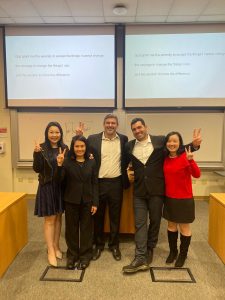As of this month, my time at USC Marshall’s Executive MBA program is one huge step closer to the finish line – we’ve just completed our capstone project, the culmination of two years of intense learning, collaboration, and real-world application.
The capstone was designed to simulate a real-world strategic decision – with a twist. Each team was assigned a major M&A transaction that had already occurred, and we were told to analyze it as though we were either the executive leadership team or the board, taking a position for or against the acquisition. We didn’t get to choose our stance – just the acquisition. The goal was to make the strongest possible argument for our assigned side, using real data, industry context, and strategic rationale.
Our Case: Against the Abiomed Acquisition
Our team – made up of Carlo Alcazar, Fannie Leung, Shirley Pu, Soe Win, and myself – was assigned the acquisition of Abiomed by Johnson & Johnson. And we had to argue against it.
To be honest, that made things tough. The Abiomed deal, completed in late 2022, is now seen as a strategic win for J&J. But digging deeper, we uncovered a number of financial, operational, and market-based concerns that could have legitimately derailed the acquisition had it been under review.
Some of the key points in our case:
-
A 58x EBITDA multiple and 15x revenue multiple – astronomically high by any benchmark
-
Significant risk of overestimating market potential for Abiomed’s Impella system, which serves a very narrow patient population
-
A limited global expansion path, with >80% of revenue still based in the U.S.
-
Long clinical trial timelines and FDA bottlenecks that could delay revenue
-
Lack of synergy between Abiomed’s product line and J&J’s existing cardio portfolio – different customers, different R&D culture, different sales channels
-
Brand risk to J&J in absorbing a niche, high-risk cardiac product line
Even with an earnout structure built into the deal, our group made the case that the premium paid far exceeded the likely return, and that J&J could have achieved similar innovation gains through targeted internal R&D or strategic partnerships – without the integration risk.
Inside Support: A Huge Thank You
We were fortunate to receive help from TTG’s Chairman of the Board, Paul Murphy, who connected us with Bering Tsang, a banker at Goldman Sachs who worked on the Abiomed deal.
Bering generously shared behind-the-scenes insight into the mechanics of the deal, the decision-making process, and the landscape J&J was navigating at the time. His perspective helped our group anchor the analysis in reality and elevate the quality of the presentation. We’re incredibly grateful to both Paul and Bering – their support made a huge difference.
Final Thoughts
I’m so proud of what our team accomplished. We worked together through late-night sessions, stacks of earnings reports, and hours of modeling and debate. In the end, we delivered a compelling case with strategic depth – and did it in true C.H.E.E.R.S. fashion (yes, that was our team name!).
This project brought together every facet of the EMBA program – finance, leadership, operations, M&A strategy, and real-world pressure. It was exactly the kind of capstone I hoped for when I started this journey.
Onward and upward.

– Vince
